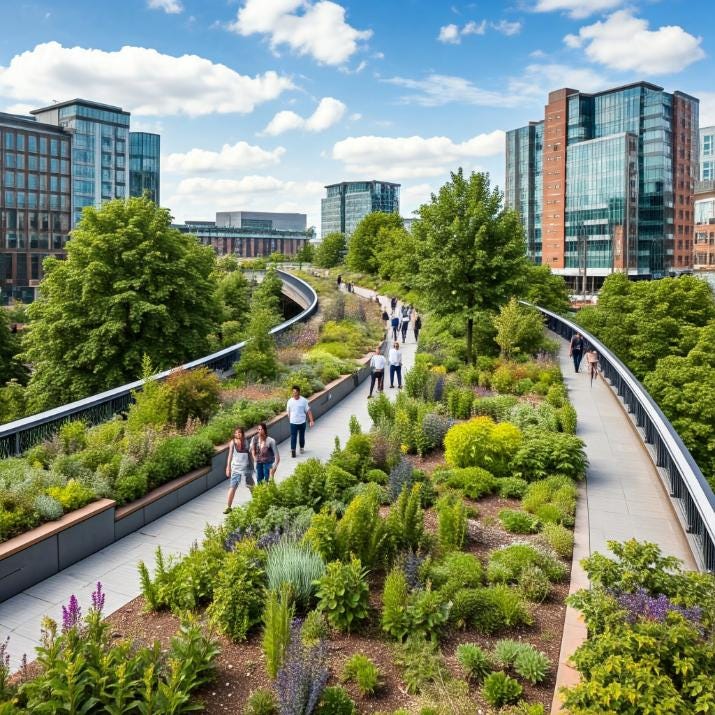Parking idea for future of flyover
Urban park is one proposal for Gateshead flyover re-use competition instead of demolition. Tony Henderson reports

A competition has been launched for ideas on how the Gateshead flyover could be put to imaginative new uses – such as an urban park - instead of being demolished.
The Flyover Futures venture, backed by the Northern Architectural Association, is organised by the Farrell Centre at Newcastle University.
The centre, named after Newcastle graduate and international architect Sir Terry Farrell, operates as a platform for debate on architectural and planning and the future of cities.
“Plans have been announced to demolish the Gateshead flyover, but we don't think demolition is the answer, which is why we're launching Flyover Futures – an ideas competition to explore alternative futures for the concrete structure,” said centre director Owen Hopkins.
Four winning projects will be displayed in an exhibition at the Farrell Centre in May.
Read more: Ian Shaw on Jaws and playing his dad in play coming to Newcastle
In December, the Gateshead flyover was suddenly closed after the discovery of structural defects that could have led to its collapse.
The closure led to immediate and extensive transport disruption, with traffic diverted to surrounding roads and the Metro suspended.
Strengthening work has allowed the Metro to now run safely, but with the flyover unlikely to ever re-open, the centre predicts that disruption looks set to continue indefinitely, with significant economic effects on local shops and businesses.
Leaders at both council and regional level have advocated for the flyover’s demolition and replacement with a new surface-level boulevard as the only option.
“However, with discussion about its replacement ongoing since 2009, and with little prospect of funding from central government to make this possible, it could be a long wait,” said Mr Hopkins.
“At the same time, demolition has significant environmental costs in terms of both the work itself and the act of disposing of countless tonnes of concrete.
“This ideas competition looks beyond demolition to explore the possibilities for re-using, re-imagining and re-constituting the Gateshead flyover and what that could offer the city and the region, from the environmental and economic upsides, to the opportunities for supporting health, wellbeing and civic pride by creating a new green space in the heart of Gateshead.”
Entries will be reviewed by a panel of experts who will select the winning projects. The area of focus is the elevated section of the flyover between St Edmund’s Road to the south, and Gateshead Foodbank to the north.
Mr Hopkins said: “We are looking for bold, original and compelling ideas for new uses for the Gateshead flyover.
“Due to structural defects, the flyover is currently closed to vehicular traffic and will remain so. However, we assume it is capable of safely supporting pedestrians and active transport, as well as static loads.
“We are interested in how a structure that bisects central Gateshead, acting as a barrier in the cityscape, could become a connector; how a structure originally intended to facilitate movement, could become a destination; and how somewhere that has limited ecology at present, might become ecologically vibrant.
Read more: Timely exhibition highlights complexities of motherhood
“It is central to the ideas competition that the bulk of the structure is retained. However, we welcome ideas for adapting it, opening it up and manipulating it in different ways. How and where the flyover might be accessed from is a key consideration.
“The focus is the flyover itself and potentially the unused spaces underneath, rather than the surrounding area. However, we hope that compelling ideas for reuse would help catalyse the inclusive re-development of the immediate environment.
“We are interested in ideas that are surprising and transformative. Feasibility and pragmatic considerations are important, but we don’t want proposals to be constrained by them.”
Possible new uses for the flyover must be accessible to everyone and free, though proposals that offer ideas for financial as well as ecological sustainability are welcome.
The competition is open everyone, but could include architects, designers, planners, landscape architects, students, community groups, artists and enthusiasts.
“We especially welcome entries from collaborative teams that bring together a range of disciplines and backgrounds,” said Mr Hopkins..
Submissions should be sent via email to hello@farrellcentre.org.uk They should comprise a short text (max 300 words) outlining ideas, approach/ways of working and ambitions and a maximum of three images and should also include biographies of the teams or individuals putting forward the submission.


